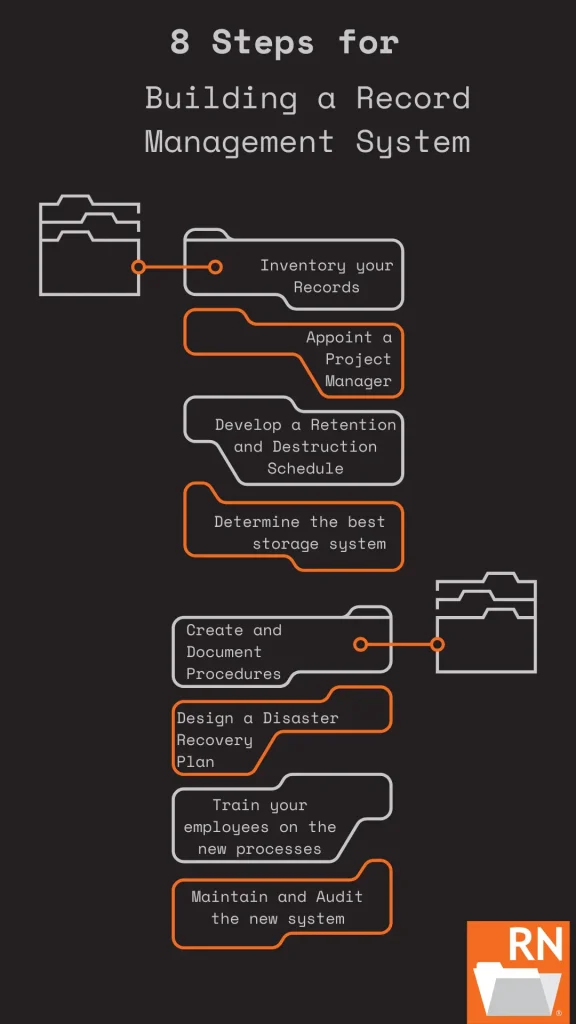
In today’s data-driven world, businesses rely on an overwhelming amount of information to make informed decisions. Every document — from emails and reports to contracts and employee records — plays a crucial role in representing a company’s values, actions, and obligations. Managing this information effectively isn’t just about organization. It’s a matter of preserving your company’s legacy, minimizing legal risks, and enhancing workflow efficiency. This is where a comprehensive records management system becomes essential.
A robust records management system can help businesses maintain, retrieve, and securely dispose of records, all while ensuring compliance with regulatory requirements. In this article, we’ll break down the differences between documents and records. We’ll also run through the benefits of a records management system, and provide a step-by-step guide to implementing a solution that fits your organization.
The Difference Between Records and Documents
While it might be tempting to use “records” and “documents” interchangeably, these terms represent distinct concepts in information management:
- Documents: Used daily, edited frequently, and have a shorter retention period. Examples include drafts, memos, and reports.
- Records: Finalized and unaltered, often with legal or compliance significance. Examples include employee records, contracts, and government filings.
Documents may evolve into records once they’re finalized and deemed legally binding. This distinction is critical in understanding how to create an effective record management system that handles both document and record retention appropriately.
What is a Records Management System?
A records management system uses management techniques to ensure the records align with the company’s legal principles and properties. It also acts as a management system to propose, develop, and apply compliance policies and procedures.
An effective record keeping system also allows the creation of regulatory schedules and protects records against unauthorized loss or access. It focuses on maintaining the entire lifecycle of a record until you need to dispose of it. In addition to all that, these records management systems can help increase productivity, mitigate risks, and protect against data breaches and compliance issues.
The Benefits of Record Management Systems
Having a functioning records management system in practice can benefit your business more than you might realize. Records management systems can improve efficiency, provide faster records retrieval, enhance workflow, and help minimize risks associated with legal compliance and data breaches. Here are some of the specific reasons you should consider investing in a records management system in your business.
Easier Compliance
As records management regulations continue to grow stricter, it’s become even more important for businesses to have a solid records management system to comply with these regulations. The following are key regulations that have requirements for records and how to manage them:
- Health Insurance Portability and Accountability Act (HIPAA)
- Fair and Accurate Credit Transactions Act (FACTA)
- Health Information Technology for Economic and Clinical Health Act (HITECH Act)
Having a records management system that meets these requirements means you can integrate and comply with these regulations more easily.
Financial Savings
If your business handles large amounts of reports, emails, and documents daily, sorting and storing all that information can be time-consuming and costly. A records management system provides better organization and storage options for your documents, giving you greater control over your records. This improved efficiency ultimately saves your business both time and money.
Faster Retrieval
Information is only useful if you can easily access it. A records management system, especially one that’s cloud-based, makes it simple to retrieve documents. It also helps you quickly remove outdated or unnecessary files, allowing you to focus on what matters. With a cloud system, employees can regularly share and update data, boosting overall efficiency.
Better Workflow
Searching for and organizing records can take hours, especially if documents are scattered across filing cabinets. A unified records management system eliminates this hassle, making it easier for you and your team to find what you need when you need it. This streamlines your workflow and allows your business to operate more effectively.
Data Protection
Data protection is a major concern for many companies. An intelligent records management system can secure personal files and confidential information, protecting against identity theft and cyber-attacks. These systems can digitize your incoming documents, storing them in a secure yet accessible archive. With modern records management, sensitive data stays protected but remains easy to retrieve.
Preserve Records
A records management system helps preserve the extensive data your company accumulates over time. Centralized storage makes it easy to reference past information for future planning and decision-making. Every record your business saves can be valuable for fact-checking or verifying details, serving as a valuable resource for your company’s growth.
Minimize Risks
Unfortunately, businesses without a solid records management system are more likely to face lawsuits or legal fines. A thorough system can help lower the chances of problems related to how documents are stored or disposed of.
Another important consideration is that a lot of legal trouble can come from getting rid of important documents too soon. With a records management system, however, it’s easy to remove documents only when it is safe to do so without incurring legal action.
How to Design and Implement a Record System in 8 Steps
Setting up a records management system requires a strategic approach, especially in an increasingly digital environment. If you’re looking to simplify your workflow, then a records management system can provide the automation and management you need to resolve many types of paper-related problems.
However, even if you work with a cloud-based program that provides record management services, it’s still important to establish the policies for your records and integrate them into your business model. Use this short, step-by-step guide on how to establish those policies and incorporate an efficient records management system into your company.
Step 1: Inventory Your Records
Start by taking a complete inventory of all records you need to manage. Organize and review your documents so you have a clear understanding of your project’s scope. Once this is done, begin researching different record management systems, focusing on their benefits and costs. This will help you choose a system that meets your data management needs.
Step 2: Define Access Roles
Decide who will handle each step of the record management process. Clearly define access roles and responsibilities to make the system easy to understand and scalable. Having clear roles also helps ensure security and consistency in managing records.
Step 3: Set Up a Retention Schedule
Create a schedule that defines how long to keep each type of record and when to dispose of it. This helps keep your system organized, prevents clutter, and ensures that only relevant records are retained. Outline specific guidelines for destroying outdated documents safely and securely.
Step 4: Choose Storage Options
Explore storage options such as document management systems, cloud storage services, and even secure offsite record storage facilities. Each has pros and cons depending on your budget, workflow, and business needs. Take time to compare these options to find the best fit for your records management goals.
Step 5: Document Procedures
Establish clear, documented procedures for handling records. Define who has authorized access, explain how to organize and locate documents, and outline data protection measures. Include instructions for properly disposing of outdated documents to ensure compliance and security.
Step 6: Plan for Disaster Recovery
Develop a disaster recovery plan to protect your records in case of cyberattacks, natural disasters, or other incidents. This plan should include regular data backups, secure storage methods, and preventive steps to protect your physical workspace. Assess your options for backup systems and the costs involved. Note that these costs include maintenance, preventing environmental damage to your office, and security measures in the case of a potential data breach.
Step 7: Train Your Team
Train your employees on the new records management procedures. Include instructions on using document software, understanding access permissions, and handling sensitive data. Also, educate them on data breach protocols and the timeline for retaining and disposing of records.
Step 8: Maintain and Audit
Regularly monitor your records management system to identify any issues or inefficiencies. During the first year, document any challenges that arise and update procedures as needed. If any problems or inefficiencies do occur, you can update and create new procedures to help address those issues for a more efficient records management system.
Develop Your Records Management System with Record Nations
Implementing a comprehensive records management system can be challenging, but partnering with an experienced provider like Record Nations can make all the difference. Record Nations brings unparalleled expertise to the table through our trusted network of professionals. Our local partners offer a range of services that include secure document scanning, cloud storage solutions, and records management consultation. With a commitment to helping businesses protect, organize, and access their information, Record Nations helps ensure companies can handle their records confidently and in full compliance with regulatory standards.
By working with Record Nations, you gain access to industry-specific knowledge and a network of service providers dedicated to creating a records management system that truly works for your organization. Whether you’re in the healthcare, legal, or financial industry — or any sector that values data integrity — Record Nations can help you optimize your records management approach.
Record Nations helps digitize documents for easy access and enhanced security, transforming your physical records into digital files. By digitizing documents, your business can streamline operations and improve data accessibility. This means less time worrying about compliance and more time focusing on growth.
Ready to simplify and strengthen your records management? Contact Record Nations today to explore the ideal records management solution tailored to your business. Our team is ready to help — call us at (866) 385-3706 or fill out our form to start your journey to organized, secure, and efficient record-keeping.










